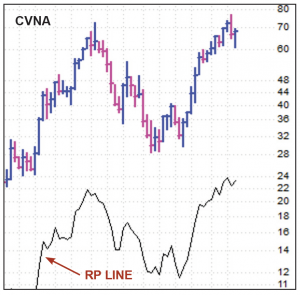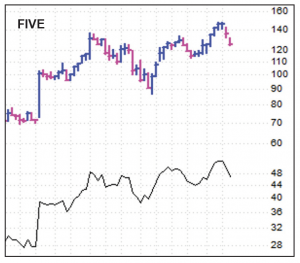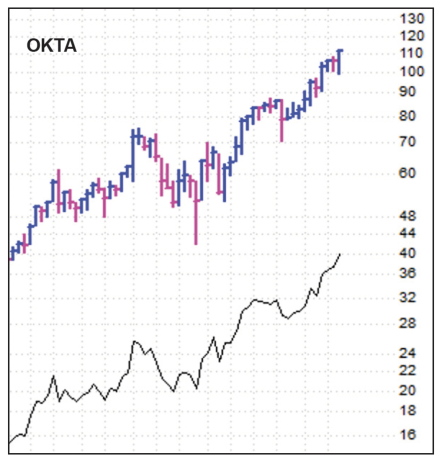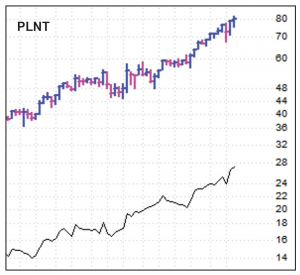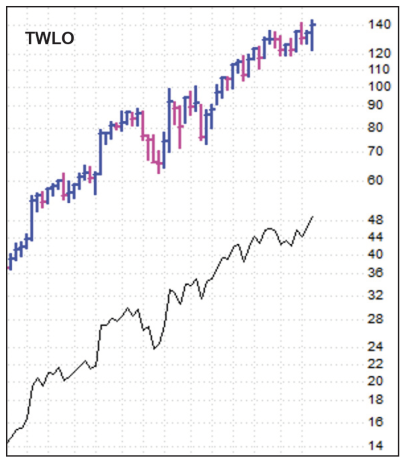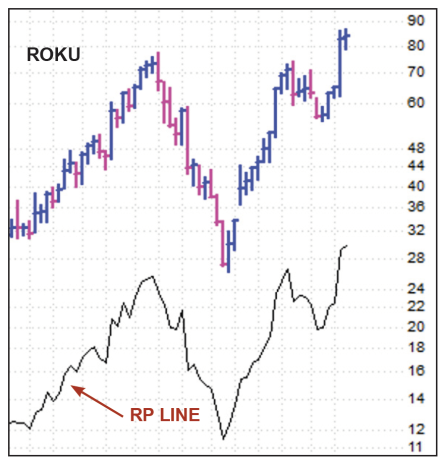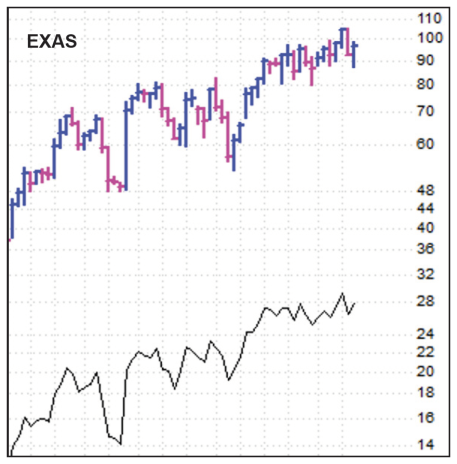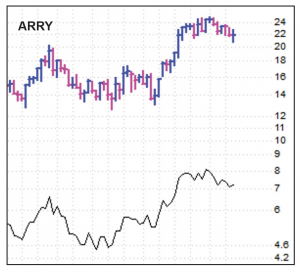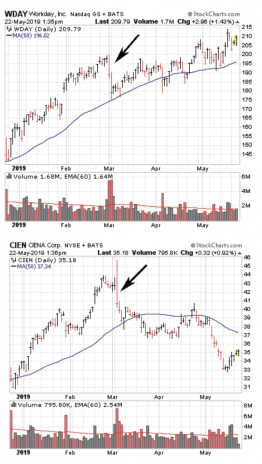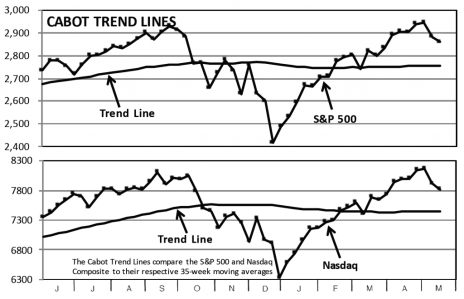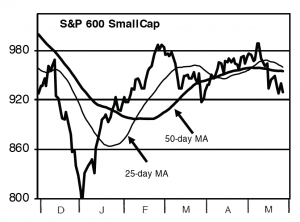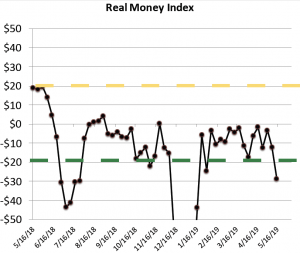The market correction continues, and we’re now seeing the selling pressures broaden, with many resilient growth stocks beginning to come under pressure. The longer-term evidence remains positive, so this is still an overall bull market, but our intermediate-term Cabot Tides are clearly negative, so we advise being cautious—cutting back on new buying, holding a chunk of cash and keeping losers and laggards on tight leashes.
Cabot Growth Investor 1420
[premium_html_toc post_id="177973"]
Time Likely Needed
In The Perfect Speculator (written by Brad Koteshwar), fictional trader Boyd Hunt said, “Everything in the market takes time. Learning takes time. Making gains takes time. Even losing big takes time because the market will occasionally offer small crumbs to remove fear.” (We recommend it as a good book to throw in your beach bag if you haven’t yet read it.)
Another thing that usually takes time is a market correction, which serves to shake and wear out some weak hands that got in during the prior advance, allow big investors to reposition chunks of their portfolio and (usually thanks to worrisome headlines, which we’re seeing lots of these days) dampen sentiment among most investors—effectively reloading the cannon for the next upmove.
That’s something that popped into our mind when flipping through the charts of the major indexes this week: After a straight-up rally for 18 weeks that wiped away the fears of late last year (economy, Fed, political uncertainties, trade war), the market probably needs more than just three weeks (the length of the correction so far) for the selling pressures to exhaust themselves.
That’s not to say we’re expecting doom and gloom. In fact, we’re pleased to see the complacency that had been built up by late April quickly fall by the wayside; money flows have turned very negative and other sentiment measures have quickly turtled. (See page 7 for more on that.) And nothing that’s occurred during this selling wave has knocked us off our view that the major indexes are likely to be higher a few months down the road—our Cabot Trend Lines are bullish, most leading stocks (while taking some lumps) are hanging in there and many studies tell us this remains a bull market.
In a nutshell, we’re longer-term bullish, and thus are attempting to hold onto our winners, thinking that many will come out of this valley and help lead the next sustained advance. But with our Cabot Tides clearly negative and many areas of the market under pressure, it’s important to tread lightly and avoid complacency—and take action if need be.
[highlight_box]WHAT TO DO NOW: Be cautious. The Model Portfolio has hung in there pretty well during this month’s correction, but the ongoing weakness is causing us to trim a bit more tonight—we’re selling one-third of our ProShares S&P 500 Fund (SSO), giving us nearly 32% in cash. We’re also going to place Chipotle (CMG) on Hold. Details below.[/highlight_box]
Model Portfolio Update
We were pleased with how the Model Portfolio acted during the first couple of weeks of the correction—there were a couple of potholes, but only one of our stocks (Five Below) really took it on the chin. But now the sellers are starting to come around for names that have meat left on the bone; today’s selloff saw most growth stocks get hit, with one of our stocks (CMG) flashing some abnormal action.
That’s not to say growth stocks look terrible. In fact, while today the Nasdaq pierced its low from a couple of weeks ago, many leaders are still well above their prior lows, which is a solid sign of resilience. But until the market finds its footing, the risks are to the downside. Tonight, we’re trimming our position in SSO and placing CMG on Hold, which will leave us with nearly 32% on the sideline—giving us cushion as this correction continues, and also buying power for when the bulls retake control.
Current Recommendations
SOLD—Carvana (CVNA 63)—We punted our half position in CVNA following its abnormal-looking, post-earnings selloff. To be fair, we’re not counting the stock out longer-term; shares have held above their lows during the past couple of weeks despite the market’s wobbles and a decent-sized share offering. Even so, the overall action, which includes a big run off the lows and two huge-volume selling days that took the stock down 18% (!), suggests CVNA needs (at the very least) time to consolidate and set up properly. If it’s able to do that, we could take another stab at it. But given the chart action, our loss and the negative market environment, we decided to cut bait and hold the cash.
HOLD—Chipotle Mexican Grill (CMG 667)—Good-looking stocks can get hit in a hurry in bad markets, and that’s what we saw with CMG today, where an analyst’s downgrade based on higher input costs (pork prices are heading higher) caused the stock to gap down on big volume today, diving below its 50-day line. We doubt the news is all that meaningful from a sales and earnings perspective (Chipotle even stated it thought the analysis was off), but it’s the stock’s reaction to the news that counts, and today’s reaction was abnormal looking for the intermediate-term. So here’s our plan. First, we’ll place the stock on Hold tonight to respect the repeated failures in the 720 area and today’s breakdown. Second, we want to give our position some rope—we still think the odds favor this being a correction, not a major top for CMG—but because our open profit exceeded 20%, we’re certainly not going to let our P&L move into the red (we got in around 609). Hence we’ll use a mental stop in the 620 to 630 range; we could tighten that going forward depending on the market or the stock’s action, but right now, we’re going to give the stock some room and see if/where it can find support.
HOLD—Five Below (FIVE 131)—Five Below has been our worst performer during the market’s May retreat, and the reason is obvious—it’s our only stock that is directly caught in the fire between the U.S. and China tariff (and now blacklisting) war. We sold one-third of our remaining position a week and a half ago, but we’re OK giving the rest of our shares time to get their act together—even if tariffs stay up for a long time, the company will likely find a way to blunt the impact (including via some higher prices, which is similar to what Walmart hinted at in its conference call this week), and if (when?) the bickering ends, we have no doubt that Five Below will do very well as it executes on its plan. Encouragingly, after the stock fell in a straight line from 148 to 125, FIVE saw two big-volume days of support this week, a sign some big investors are comfortable adding to their position down here. We’re not ready to join them on the buy side, but we’re OK hanging on.
BUY—Okta (OKTA 108)—Our thesis near the start of the year was that Okta was one of a small number of “new age” cybersecurity stocks that were set to be leaders, and that’s proven true thus far, with the stock continuing to trend higher despite the soggy market. (Zscaler (ZS) and CyberArk (CYBR) are two others that continue to act well.) That said, the stock’s near-term future will likely be determined by next week’s earnings report (Thursday, May 30, after the market close); analysts are looking for revenues of $117 million (up 40%) and a loss of $0.21 per share. As we write about on page 7, we’ve seen a ton of sour earnings reactions among our stocks this year, and given OKTA’s recent run and the iffy environment, we certainly can’t rule out a bout of profit taking even if the numbers are “good.” That said, barring a complete meltdown (something down into the mid 80s), we’ll probably hold on should any short-term weakness arrive, thinking Okta’s long runway of growth will likely have more big investors building positions. We’ll stay on Buy, but keep new positions small and look to buy on dips of a few points with earnings a week away.
BUY—Planet Fitness (PLNT 74)—After a great post-earnings run over 80, PLNT has hit some turbulence, selling off on increasing volume in recent days (and, according to our options guru Jacob Mintz, has seen a modest pickup in put buying). Given the stock’s advance since the start of March (it hasn’t closed much below its 25-day line during that time) and the intermediate-term downtrend in the market, some further weakness could be in store, and we’re open to any scenario given that the stock has had a big run during the past year or two. But, until proven otherwise, we’re going to assume the path of least resistance remains up as the firm’s business isn’t dependent on the overall economy and has plenty of white space for expansion both in terms of number of gyms and revenue per member. If you don’t own any, you can grab shares on this dip, but keep new positions small because of the market.
SELL ONE-THIRD, HOLD THE REST—ProShares Ultra S&P 500 Fund (SSO 116)—We’re torn when we look at SSO, a leveraged index fund (it moves twice the S&P 500 on a daily basis) that we began buying back in January, just a couple of weeks off the major market low. On the one hand, the odds continue to favor this being an overall bull market, so the fund should work its way higher over time—possibly much higher if the persistent January-April advance was the kickoff of a new bull phase. On the other hand, as we wrote on page 1, it’s also likely that the current correction needs more time (and may have to inflict more pain) before it’s over, and we also can’t ignore that we have a big position (14% of the portfolio) in the Model Portfolio. If you want to sit tight and ride through the correction, we don’t think there’s anything wrong with that (especially if you have a more modest-sized position relative to your account). But taking everything together, we think it’s best to do a little trimming in tonight’s issue, selling one-third of our total position. If some of the longer-term evidence (Cabot Trend Lines, etc.) turn bearish, we might sell more, but the plan after tonught’s partial sale is to give the rest of our SSO position room to correct and, eventually, resume the longer-term uptrend.
BUY—Twilio (TWLO 133)—We make it a point not to get too close to our stock’s day-to-day action, which usually gins up emotions (and confusion), leading to poor decisions. But sometimes a little extra focus is warranted, and TWLO’s action last week caught our eye—after the stock dove below its 50-day line on heavy volume (its first decisive dip below that trend line all year), TWLO immediately went nuts on the upside, rallying 15% to new price and relative performance (RP) peaks over three days, all of which came on impressive volume. That sort of shake-and-snap action in a leading stock is great to see, effectively telling you there are tons of big investors wanting to build positions on dips. Obviously, the overall environment is going to have an impact—TWLO fell sharply today along with most growth stocks—but it’s showing some relative strength as its low this week (131) is well above its prior nadir (123), even as the Nasdaq is hitting lower lows. We’re not whistling past the graveyard, but we still think you can start a position on this dip if you don’t own any and have some cash on the sideline.
HOLD—Workday (WDAY 205)—We’ve come close to throwing Workday overboard a couple of times in recent months, but every time we’re about to jettison it, the stock finds support and bounces. That’s exactly what’s happened this month, with shares holding their 50-day line and, last week, actually pushing to new highs! That’s great to see, and along with a bunch of positive analyst commentary regarding some potential huge customer wins, boosts our confidence that WDAY can move higher once the market’s correction finishes up. That said, the stock’s true tale will be told next week—the company is reporting earnings Tuesday (May 28) after the closing bell, with analysts looking for 32% revenue growth and earnings of $0.41 per share. We think there’s a good chance the stock’s rest in March and April can lead to a good upmove, so if WDAY holds up (or gaps up) after earnings, we’d like to go back to Buy. But right now it’s prudent to stick with a Hold rating and see what comes.
Watch List
Array Biopharma (ARRY 26): ARRY has been one of the best biotech stocks out there in terms of action and its growth story—and both of those factors got a big boost this week. See page 6 for more.
DocuSign (DOCU 53): Nothing has changed fundamentally with DOCU, which, as the clear leader in e-signatures and other digital contract and agreement forms, should have years of steady growth ahead of it. The stock is now 10 weeks into a reasonable rest between 50 and 60—a powerful breakout (and a Tides buy signal) could have us jumping in.
Roku (ROKU 90): ROKU is a very volatile stock that can be hard to handle (if we bought, we’d definitely start with just a half-sized position), but the growth story is huge and management continues to execute. See below.
Shopify (SHOP 272): SHOP remains very strong, which we take as a good longer-term sign that the stock will eventually head much higher. But with the Tides negative and shares miles above support (50-day line near 230), we’re content to wait.
Tandem Diabetes (TNDM 64): TNDM continues to etch a new launching pad, though like most stocks, still has work to do.
Other Stocks of Interest
The stocks below may not be followed in Cabot Growth Investor on a regular basis. They’re intended to present you with ideas for additional investment beyond the Model Portfolio. For our current ratings on these stocks, see Updates on Other Stocks of Interest on the subscriber website or email mike@cabotwealth.com.
Roku (ROKU 90)—The trend of cord-cutting (three million people left cable and satellite cable firms in 2018, with another one million out the door in Q1 of this year) is firmly in place; in fact, streaming now makes up one in six hours of TV watching. While firms like Netflix, Amazon, Disney and others battle it out, Roku looks like one of the biggest beneficiaries of the trend. The company now has the #1 smart TV operating system in the U.S. (it just surpassed Samsung), with one in three TVs sold in the U.S. in Q1 incorporating Roku’s technology. While the company still gets some money from streaming player sales, all of the excitement is about the streaming platform—it now offers 10,000 free ad-supported shows and movies and connects to more than 30 pay offerings like those mentioned above. All told, the company has 29.1 million active accounts to its platform (up 40% from a year ago) that watched a whopping 8.9 billion hours of streaming content (up 74%) in Q1 alone, providing a huge and attentive audience to content providers, as well as tools to help those providers get and keep customers. (Importantly, Roku is a neutral player, so it’s not competing with its partners, making it far more attractive to them.) In Q1, platform-related revenues leapt 79%, driven by the increase in accounts and higher revenue per user (up 27% from a year ago), and analysts see the overall top line rising 41% this year and 34% next (faster for the platform business). Roku is still operating around breakeven on a cash flow basis, but big investors don’t mind—after years of wild moves up and down, the stock built a proper base in March and April and has surged to new highs since. Volatility is extremely high, but ROKU is a name we’d like to own once the market turns healthy.
Exact Sciences (EXAS 94)—We were shaken out of Exact Sciences earlier this year, and in recent weeks it’s been generally strong but all over the place—which has led to many questions regarding our current thoughts. First, fundamentally, nothing has really changed with the story; Cologuard is selling very well, with Q1 revenue and test volume growth both accelerating to 79%, and longer-term, management still thinks business can grow many-fold. However, the stock currently isn’t near the top of our watch list for the moment for two reasons. First, there’s growing perception that competition is coming; Guardant Health (GH) is trying out a blood test for colorectal cancer, and while it’s not close to hitting the market, it (along with the market) was enough to drive EXAS down 15% in just two days. Second, that recent selloff was a continuation of a wobbly pattern from the stock lately—while shares have made some progress since early February, they’ve also suffered pullbacks of 11%, 15%, 17%, 12% and now 15% over the past three and a half months. That’s not an indicator of certain doom, but it is a sign that buyers and sellers are beginning to fight it out on a regular basis, which isn’t ideal. To be clear, we’re not bearish on EXAS—if we owned it here, we’d hold on with a mental stop in the upper 80s, and would be happy to remain patient as long as the stock can find support. But for us to click the buy button, we’d prefer to see a change in character, with either a decisive, big-volume leap to new highs (with the ability to hold those gains) or a more persistent advance with tamer pullbacks and pauses.
Array Biopharma (ARRY 26)—Biotech stocks have been laggards this year, but we still keep our eyes open because the group can launch a few big winners once it gets its act together. One of our favorites is Array Biopharma, which is transitioning to a commercial-stage operation thanks to two drugs—Braftovi and Mektovi—that just launched in mid-2018 to treat later-stage melanoma patients with specific gene mutations. With outstanding results (nearly doubling life expectancy), sales are off to a good start; in the March quarter, these drugs brought in $35 million, up from $23 million the prior quarter and well above expectations. But there’s even more excitement for another potential treatment! This week, Array announced study results for these two drugs in combination treatments for certain gene-specific colorectal cancer patients (which, in total, account for about 15% of all CC patients), and they were great, with prolonged survival rates and response rates as high as 26% (vs. 1% with the control group), causing shares to surge back to their all-time highs on big volume. The approval process still has months to go, and even without it, analysts see the top line growing 56% this year and another 31% in 2020. But if given the thumbs-up, Array’s growth should exceed even those lofty targets.
Not Every Earnings Drop is Bearish
We don’t have any big complaints about 2019 so far—we’re sitting on decent gains and think there will be more to come once this correction ends—but one thing that’s stuck out to us is the earnings reactions of our stocks. Every one we can recall has been either negative right away or, after an initial positive move, has quickly reversed course. Even more telling, despite the strong overall market, there have been no “gap and go” situations, where a stock gaps up on the report and keeps chugging higher.
This has been frustrating to live through, but two thoughts come to mind. First, these things tend to be cyclical—this year so far has seen poor reactions, but eventually, that trend will reverse.
Second and more important, just because a stock gets clonked on earnings doesn’t means it’s done for. The key, as with most things, is to not make a decision based solely on the stock’s action over a day or two, but instead to look at the earnings move in context of the stock’s recent action.
Take Workday (WDAY), which was looking pristine when it reported earnings at the end of February—but two days later, it had fallen 12.5% on giant volume! But shares held above their 50-day line, which told us to give it a little wiggle room. So we set a relatively tight mental stop, and WDAY steadily marched back toward its old peak three weeks later. All in all, it’s etched higher lows since then and even tagged new high ground last week. A drop below 190 at this point would be a worry (earnings are out next Tuesday) but so far, so good.
Conversely, look at Ciena (CIEN), which had all the qualities of a new leader coming out of the market’s fourth quarter decline. However, the stock got hit on three straight days in early March, and the bounce after that was feeble. We lost patience with it in early April (it had been living below its 50-day line) and you can see the action since then.
Thinking back a decade or two, earnings gaps weren’t well understood; that’s why so many of them (up or down) persisted after the initial gap. But now they’re commonly followed, which is probably one reason we’re seeing more wobbles—there are more games being played ahead of reports that can cause wild, but temporary, reactions.
Regardless of the reason, ideally our luck will change as we have another couple of earnings reports coming up (Okta is May 30). But even without the benefit of strong overnight gaps up, you can still do fine if you keep things in perspective.
Follow the Money
When it comes to sentiment measures, we’ve grown fond of tracking real money-based measures of investor sentiment, as opposed to surveys of what people think of the market; money flows to equity funds and ETFs, narrow measures into leveraged long funds and even put-call ratios are our favorites. As usual, these measures tend to be contrary, so big inflows often lead to a tricky market, while huge outflows generally precede solid upmoves.
What’s interesting is that, despite the heady rally in stocks this year, there hasn’t been much excitement when it comes to the man on the street. Shown below is a chart of the cumulative money flows into all equity funds and ETFs this year (according to Lipper)—despite the overall bull move, more than $43 billion has been yanked out of funds!
We see a similar lack of enthusiasm when looking at narrower measures, too. The total amount of assets in Rydex bullish funds (including sector and leveraged index funds) never came close to its 2018 highs in April and has quickly sunk back to mid-February levels.
And these outflows have predictably intensified with the market correction that began at the start of May. In fact, our own Real Money Index (see page 8) just flashed its first green light on the year—over the past five weeks, a huge $28 billion has been pulled from equity funds (including $25 billion net over just the past two weeks).
Historically, when outflows get that large over a five-week span, it leads to above-average performance—during the past decade, such readings have seen the Nasdaq advance about 3% a month later, with 82% of occurences leading to some type of gain. Two months after the signals, the gains are average around 5%, with 88% finishing in the green.
Of course, we don’t trade directly off the Real Money Index (or any other as a sentiment measure), but it does help us lean against the wind. While we’re not going to buck the message of the Cabot Tides, if the indicator is still in extreme territory when the Tides turn bullish again, it would likely have us taking a more aggressive stance on the buy side.
Cabot Market Timing Indicators
Most of what we see continues tell us we’re in an overall bull market, but there’s no question that the sellers are doing some damage right now—we’re holding our resilient stocks, but are also holding some cash and waiting for the selling pressure to dissipate.
Cabot Trend Lines: Bullish
The Cabot Trend Lines are still firmly positioned in positive territory, holding onto buy signal that flashed in mid February—even after a couple of down weeks, the S&P 500 (by 3.7%) and Nasdaq (by 5.0%) closed well above their respective 35-week lines last Friday. Things can always change, but so far, the evidence continues to point to higher prices in the months down the road.
Cabot Tides: Bearish
Our Cabot Tides are bearish, with all of the indexes we track (especially the S&P 600 SmallCap, shown here) sitting beneath their lower (50-day) moving averages. Whether this intermediate-term downtrend lasts a few more days or many more weeks is anyone’s guess, but right now, the onus remains on the bulls to retake control. Until then, caution is warranted.
Cabot Real Money Index: Positive
As we wrote on page 7, our Real Money Index has moved into positive territory for the first time all year, as money has gushed out of equity funds and ETFs during the past five weeks (and, in particular, over the past two weeks as the market has retreated). This pessimism is a good sign that, once the correction finishes up, the ensuing rally should be a good one.
[premium_html_footer]
Send questions or comments to mike@cabotwealth.com.
Cabot Growth Investor • 176 North Street, Post Office Box 2049, Salem, MA 01970 • www.cabotwealth.com
All Cabot Growth Investor’s buy and sell recommendations are made in issues or updates and posted on the Cabot subscribers’ website. Sell recommendations may also be sent to subscribers as special bulletins via email and the recorded telephone hotline. To calculate the performance of the portfolio, Cabot “buys” and “sells” at the midpoint of the high and low prices of the stock on the day following the recommendation. Cabot’s policy is to sell any stock that shows a loss of 20% in a bull market (15% in a bear market) from our original buy price, calculated using the current closing (not intra-day) price. Subscribers should apply loss limits based on their own personal purchase prices.
Charts show both the stock’s recent trading history and its relative performance (RP) line, which shows you how the stock is performing relative to the S&P 500, a broad-based index. In the ideal case, the stock and its RP line advance in unison. Both tools are key in determining whether to hold or sell.
THE NEXT CABOT GROWTH INVESTOR WILL BE PUBLISHED JUNE 6, 2019
We appreciate your feedback on this issue. Follow the link below to complete our subscriber satisfaction survey: Go to: www.surveymonkey.com/marketlettersurvey
Neither Cabot Wealth Network nor our employees are compensated by the companies we recommend. Sources of information are believed to be reliable, but are in no way guaranteed to be complete or without error. Recommendations, opinions or suggestions are given with the understanding that subscribers acting on the information assume all risks. © Cabot Wealth Network. Copying and/or electronic transmission of this report is a violation of U.S. copyright law. For the protection of our subscribers, if copyright laws are violated, the subscription will be terminated. To subscribe or for information on our privacy policy, call 978-745-5532, visit www.cabotwealth.com or write to support@cabotwealth.com.
[/premium_html_footer]



